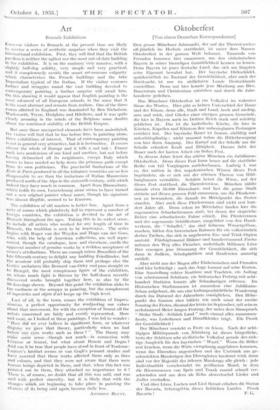Art
Brussels Exhibitions ENGLISH visitors to Brussels at the• present time are likely to receive a series of aesthetic surprises when they visit the international exhibition. First, they will find that the British pavilion is neither the ugliest nor the most out-of-date building in 'the exhibition. It is on the contrary very massive, with a slightly bull-dog solidity, very simple and very practical, and it conspicuously avoids the smart art-nouveau vulgarity Which characterises the French buildings and the false Imperialism typical of the Italian. If the visitor ventures farther and struggles round the vast building devoted to contemporary' painting, a further surprise will await him. On this :showing it would appear that English painting is the most ackaneed of all European schools, in the sense that it is the most abstract and remote from realism. One of the three rooms allotted to England was dominated by Ben Nicholson, Wadsworth, Tryon, Hodgkins and Hitchens, and it was quite clearly arousing in the minds of the Belgians some doubts about the continued stability of the British Enipire.
But once these unexpected elements have been assimilated, the visitor' will find that he has before him, in painting alone, thrce exhibitions of interest. That of contemporary painting is not in general very attractive, but it is instructive. It covers almost 'the whole of Europe and it tells a sad tale : France sunk into academism of one kind and another, but not before having debauched all its neighbours, except Italy which seems to have needed no help down the primrose path except from ' its own politicians. The provincial limitations of the Ecole de Paris produced in all the tributary countries are no less disagreeable to see than the imitations of Italian Mannerism PrOdueed north of the Alps in the sixteenth century, with which indeed they have much in common. Apart from BloomSbury, which holds its own, Luxembourg alone seems to have turned out a new original painter whose name, though his signature Was alMoSt illegible, seemed to be Kusman.
The exhibition of old masters is better fare. Apart from a suite of rooms which plaintively fail to represent a number of foreign countries,, the exhibition is devoted to the art of Brussels throughout the ages. Taking this in its widest sense, to include all artists who worked for any length of time in Brussels, the tradition is seen to be impressive. The series begins with Roger van der Weyden and Hugo van der Goes, Who, with the help of American collections, are well repre- sented, though the catalogue, here and elsewhere, swells the aPparent number of genuine works by a reckless acceptance of owner's attributions. There are enough minor Bruxellois of the late fifteenth century to delight any budding Friedlander, but the amateur will probably skip them and perhaps also the Gothic archaizers like Bernard van Orley and pass straight on to Bruegel, the most conspicuous figure of the exhibition, oft wlidm much light is thrown by the half-dozen recently dikovered works brought together here, as also by the 50 drawings shown. Beyond this point the exhibition sinks to the :mediocre or the scrappy in painting, but the complement of tapestries and objets d'art keeps up the high level.
Last of all; in the town, comes the exhibition of Impres- sionisii 1, a perfect opportunity for readjusting our values about that movement, for with the exception of Seurat all the artists concerned are fairly and evenly represented. More and more, as I looked at these paintings, I was led to wonder : How 'did we ever believe in significant form, or whatever disguise • we gave that theory, particularly when we had before our eyes works such as these ? 7, The theory may !liake some sense—though not much—in connexion with Ci•zanne or Seurat, but what about ,Renoir and Degas ? And can it be true that people have stood in front of Toulouse- Laiitree's hrothel scenes or van Gogh's peasant studies and have asserted that these works affected them only as lines and colours, and that they were not aware that there were human beings depicted in them, and that, when this fact was pOinted, 'out to them, they attached no importance to it 'There is, of course, no doubt that all this was said, and was said with perfect sincerity, but it is likely that with the changes whiCh are beginning to take place in painting the chances of its being said again become daily less. .
ANTHONY BLUNT.










































 Previous page
Previous page